TOYOTA PRIUS V 2017 ZVW40 / 1.G Quick Reference Guide
Manufacturer: TOYOTA, Model Year: 2017, Model line: PRIUS V, Model: TOYOTA PRIUS V 2017 ZVW40 / 1.GPages: 40, PDF Size: 2.08 MB
Page 21 of 40
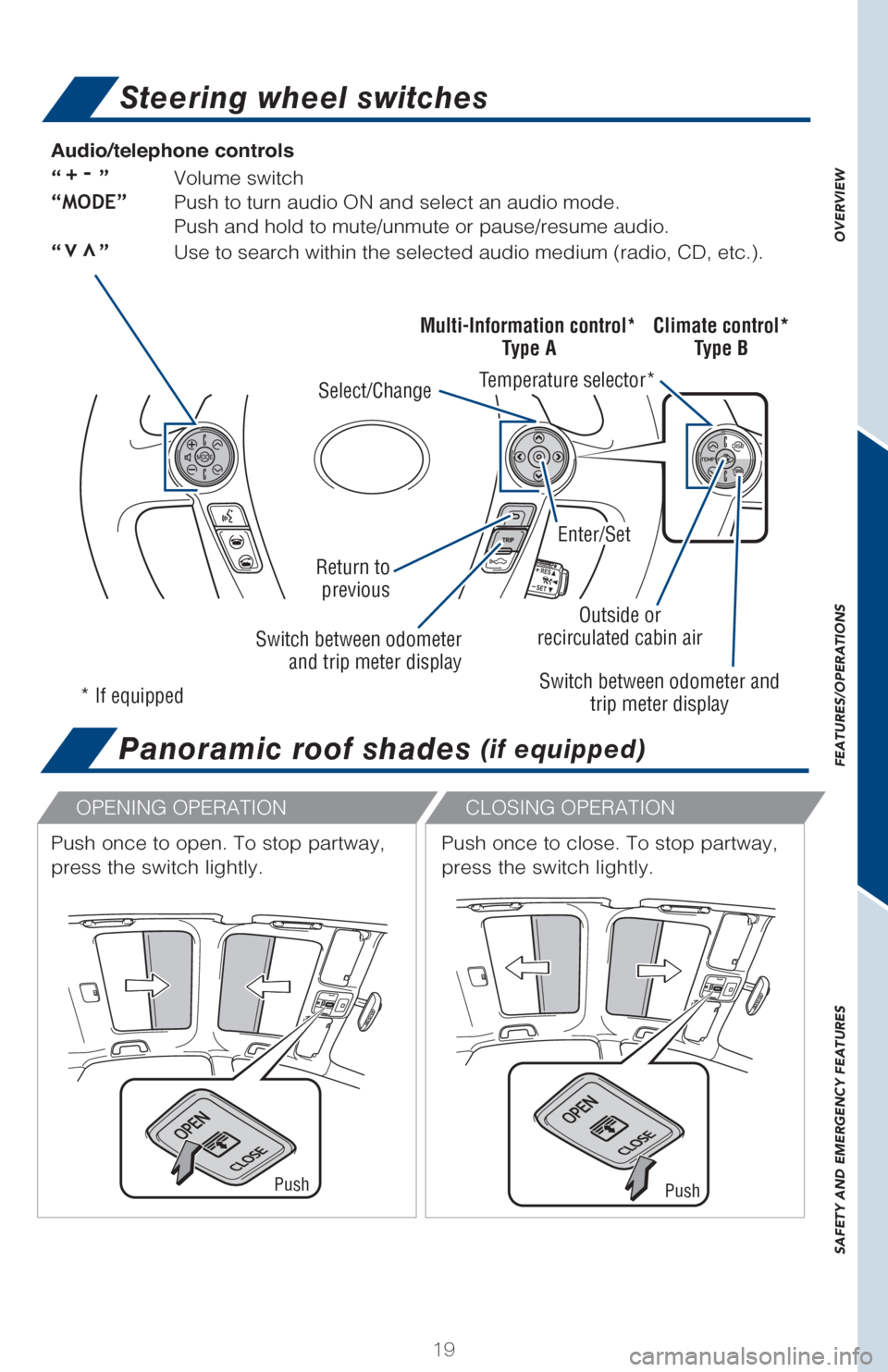
OVERVIEW
FEATURES/OPERATIONS
SAFETY AND EMERGENCY FEATURES
19
Steering wheel switches
Panoramic roof shades (if equipped)
* If equipped
OPENING OPERATION
CLOSING OPERATION
Push
Push
Push once to close. To stop partway,
press the switch lightly.
Push once to open. To stop partway,
press the switch lightly.
Multi-Information control*
Type A
Climate control*
Type B
Audio/telephone controls
“+-” Volume switch
“MODE” Push to turn audio ON and select an audio mode.
Push and hold to mute/unmute or pause/resume audio.
“vv” Use to search within the selected audio medium (radio, CD, etc.).
Select/Change
Enter/Set
Return to
previous
Switch between odometer and trip meter display
Temperature selector*
Outside or
recirculated cabin air
Switch between odometer and trip meter display
Page 22 of 40
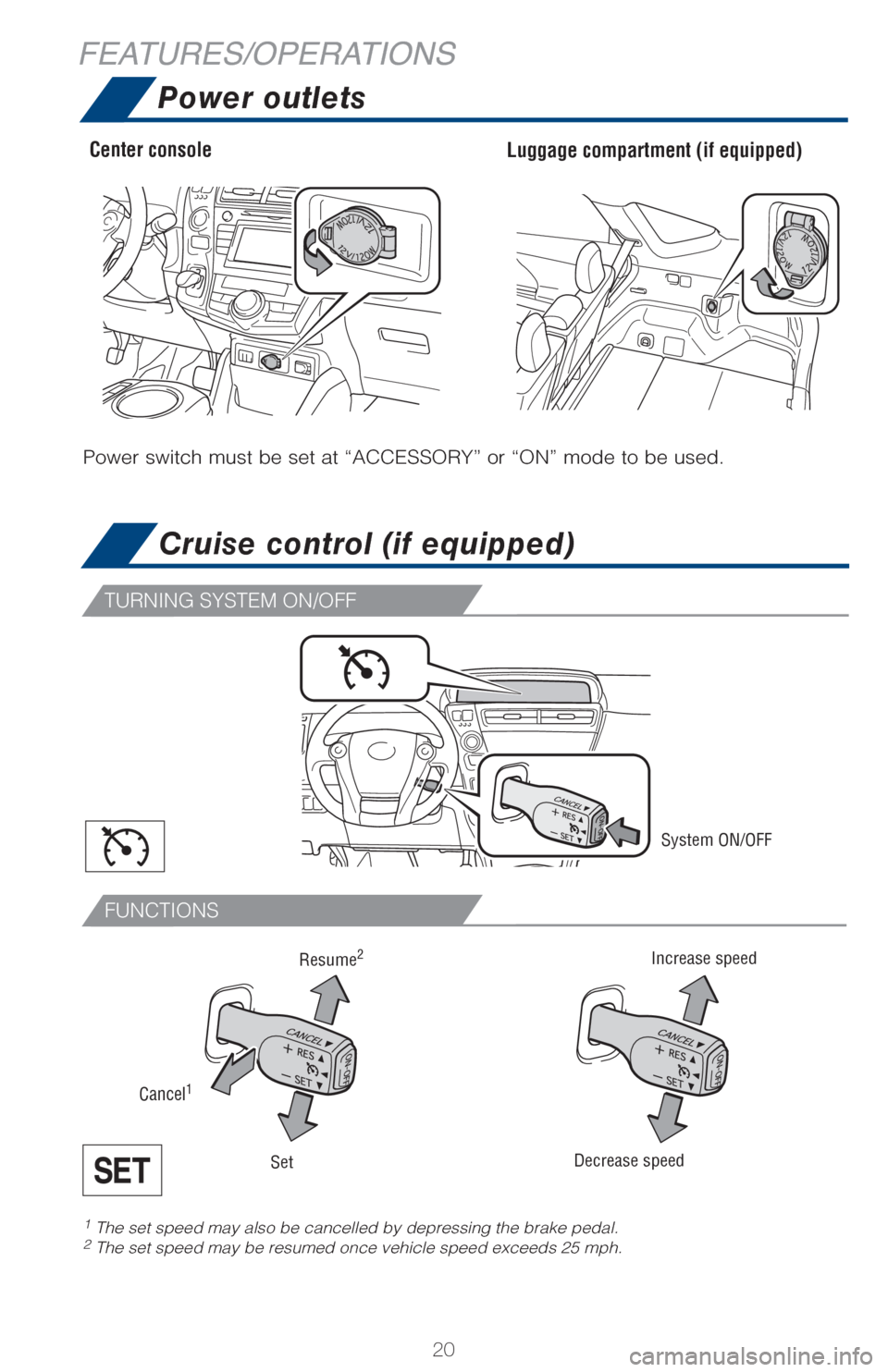
20
FUNCTIONS
TURNING SYSTEM ON/OFF
FEATURES/OPERATIONSPower outlets
Cruise control (if equipped)
System ON/OFF
Increase speed
Decrease speed
Cancel1
Resume2
Set
Center console Luggage compartment (if equipped)
Power switch must be set at “ACCESSORY” or “ON” mode to be u\
sed.
1 The set speed may also be cancelled by depressing the brake pedal.2 The set speed may be resumed once vehicle speed exceeds 25 mph.
Page 23 of 40
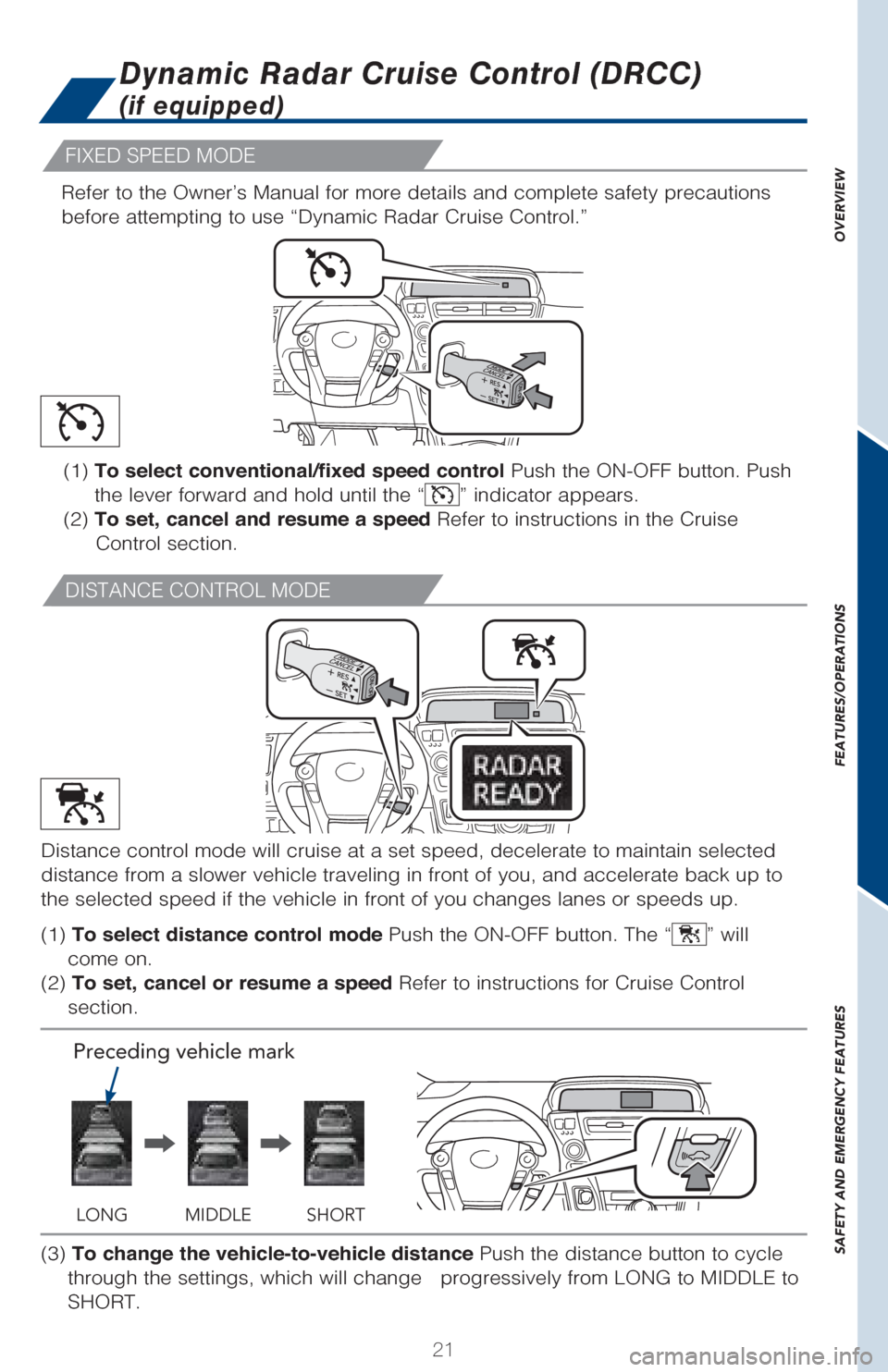
OVERVIEW
FEATURES/OPERATIONS
SAFETY AND EMERGENCY FEATURES
21
FIXED SPEED MODE
DISTANCE CONTROL MODE
Dynamic Radar Cruise Control (DRCC)
(if equipped)
(1) To select conventional/fixed speed control Push the ON-OFF button. Push
the lever forward and hold until the “
” indicator appears.
(2) To set, cancel and resume a speed Refer to instructions in the Cruise
Control section.
Distance control mode will cruise at a set speed, decelerate to maintain\
selected
distance from a slower vehicle traveling in front of you, and accelerate\
back up to
the selected speed if the vehicle in front of you changes lanes or speed\
s up.
(1) To select distance control mode Push the ON-OFF button. The “
” will
come on.
(2) To set, cancel or resume a speed Refer to instructions for Cruise Control
section.
(3) To change the vehicle-to-vehicle distance Push the distance button to cycle
through the settings, which will change progressively from LONG to MID\
DLE to
SHORT.
Refer to the Owner’s Manual for more details and complete safety prec\
autions
before attempting to use “Dynamic Radar Cruise Control.”
LONG MIDDLE SHORT
Prece
ding ve hicle mark
Page 24 of 40
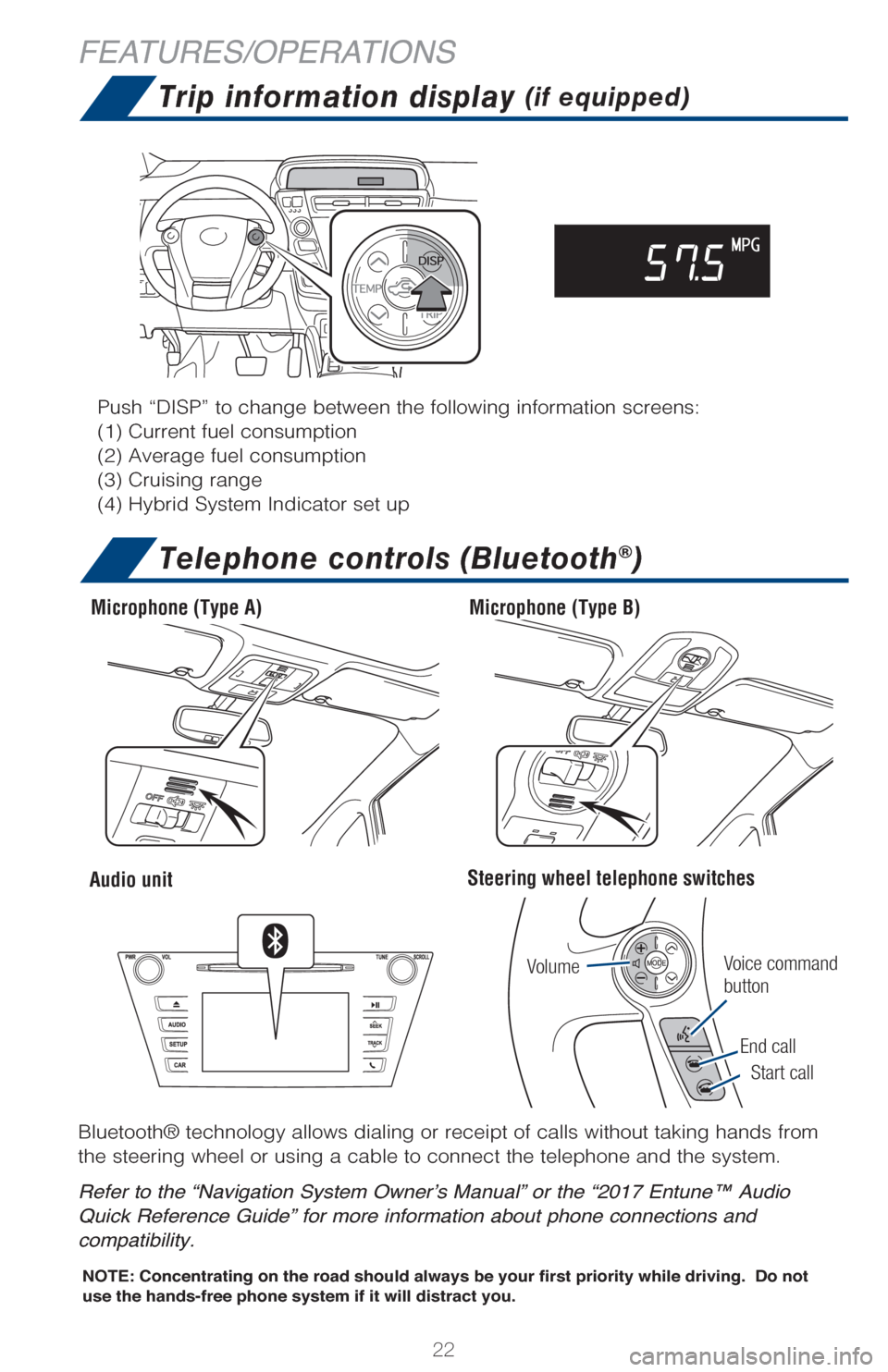
22
FEATURES/OPERATIONSTrip information display
(if equipped)
Telephone controls (Bluetooth®)
Bluetooth® technology allows dialing or receipt of calls without taki\
ng hands from
the steering wheel or using a cable to connect the telephone and the sys\
tem.
Refer to the “Navigation System Owner’s Manual” or the “2017 Entune™ Audio
Quick Reference Guide” for more information about phone connections and
compatibility.
Microphone (Type A)
Audio unitSteering wheel telephone switches
Microphone (Type B)
Push “DISP” to change between the following information screens:
(1) Current fuel consumption
(2) Average fuel consumption
(3) Cruising range
(4) Hybrid System Indicator set up
NOTE: Concentrating on the road should always be your first priority whi\
le driving. Do not
use the hands-free phone system if it will distract you.
Volume
Start call
End call
Voice command
button
Page 25 of 40
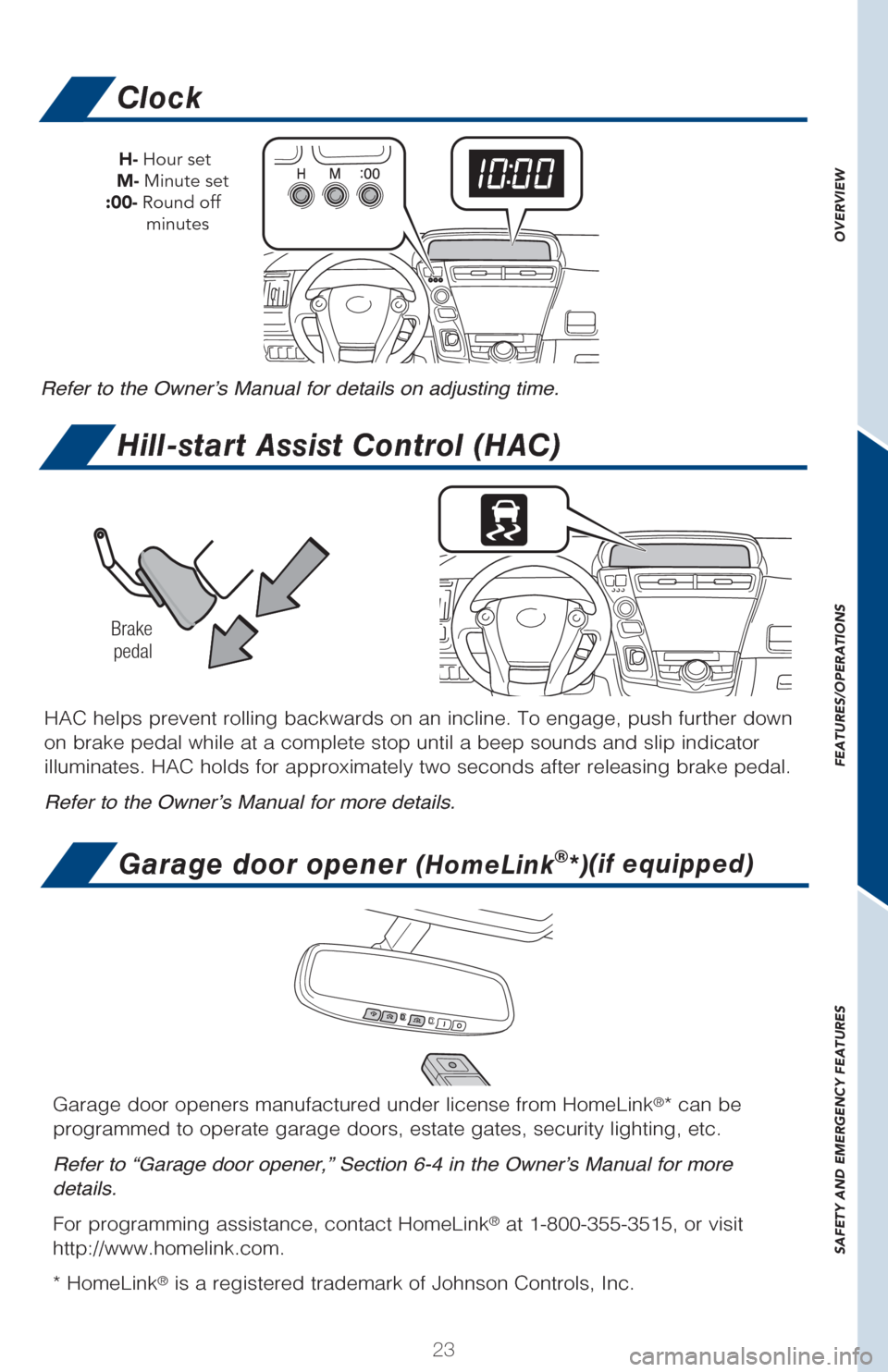
OVERVIEW
FEATURES/OPERATIONS
SAFETY AND EMERGENCY FEATURES
23
Clock
Hill-start Assist Control (HAC)
Garage door opener (HomeLink®*) (if equipped)
Refer to the Owner’s Manual for details on adjusting time.
H- Hour set
M- Minute set
:00- Round off
minutes
Garage door openers manufactured under license from HomeLink®* can be
programmed to operate garage doors, estate gates, security lighting, etc\
.
Refer to “Garage door opener,” Section 6-4 in the Owner’s Manual for more
details.
For programming assistance, contact HomeLink
® at 1-800-355-3515, or visit
http://www.homelink.com.
* HomeLink
® is a registered trademark of Johnson Controls, Inc.
HAC helps prevent rolling backwards on an incline. To engage, push furth\
er down
on brake pedal while at a complete stop until a beep sounds and slip ind\
icator
illuminates. HAC holds for approximately two seconds after releasing bra\
ke pedal.
Refer to the Owner’s Manual for more details.
Brake pedal
Page 26 of 40
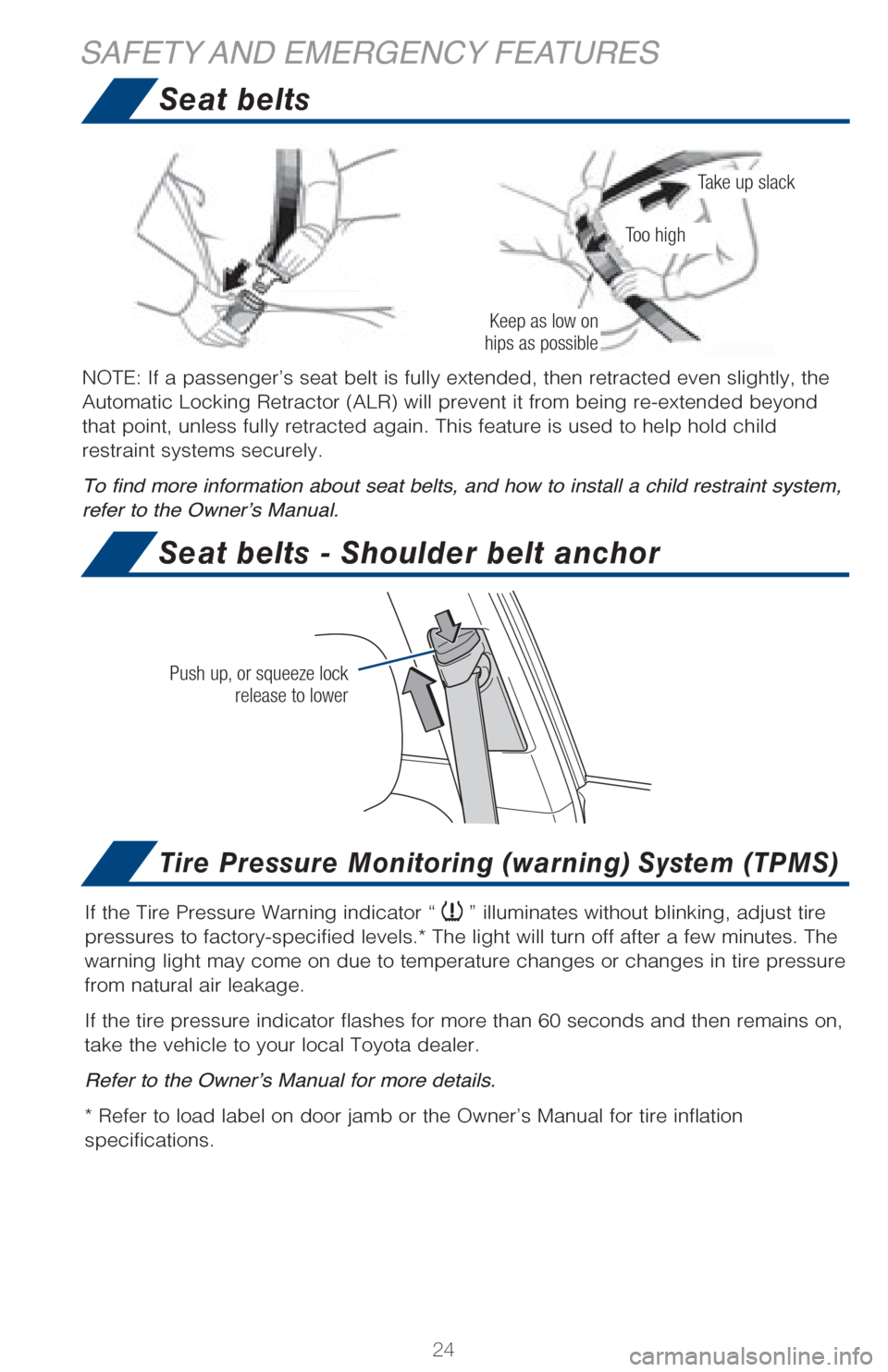
24
If the Tire Pressure Warning indicator “” illuminates without blinking, adjust tire
pressures to factory-specified levels.* The light will turn off after a \
few minutes. The
warning light may come on due to temperature changes or changes in tire \
pressure
from natural air leakage.
If the tire pressure indicator flashes for more than 60 seconds and then\
remains on,
take the vehicle to your local Toyota dealer.
Refer to the Owner’s Manual for more details.
* Refer to load label on door jamb or the Owner’s Manual for tire inf\
lation
specifications.
SAFETY AND EMERGENCY FEATURES
Seat belts
Seat belts - Shoulder belt anchor
Tire Pressure Monitoring (warning) System (TPMS)
NOTE: If a passenger’s seat belt is fully extended, then retracted ev\
en slightly, the
Automatic Locking Retractor (ALR) will prevent it from being re-extend\
ed beyond
that point, unless fully retracted again. This feature is used to help h\
old child
restraint systems securely.
To find more information about seat belts, and how to install a child re\
straint system,
refer to the Owner’s Manual.
Keep as low on
hips as possible
Take up slack
Too high
Push up, or squeeze lock release to lower
Page 27 of 40
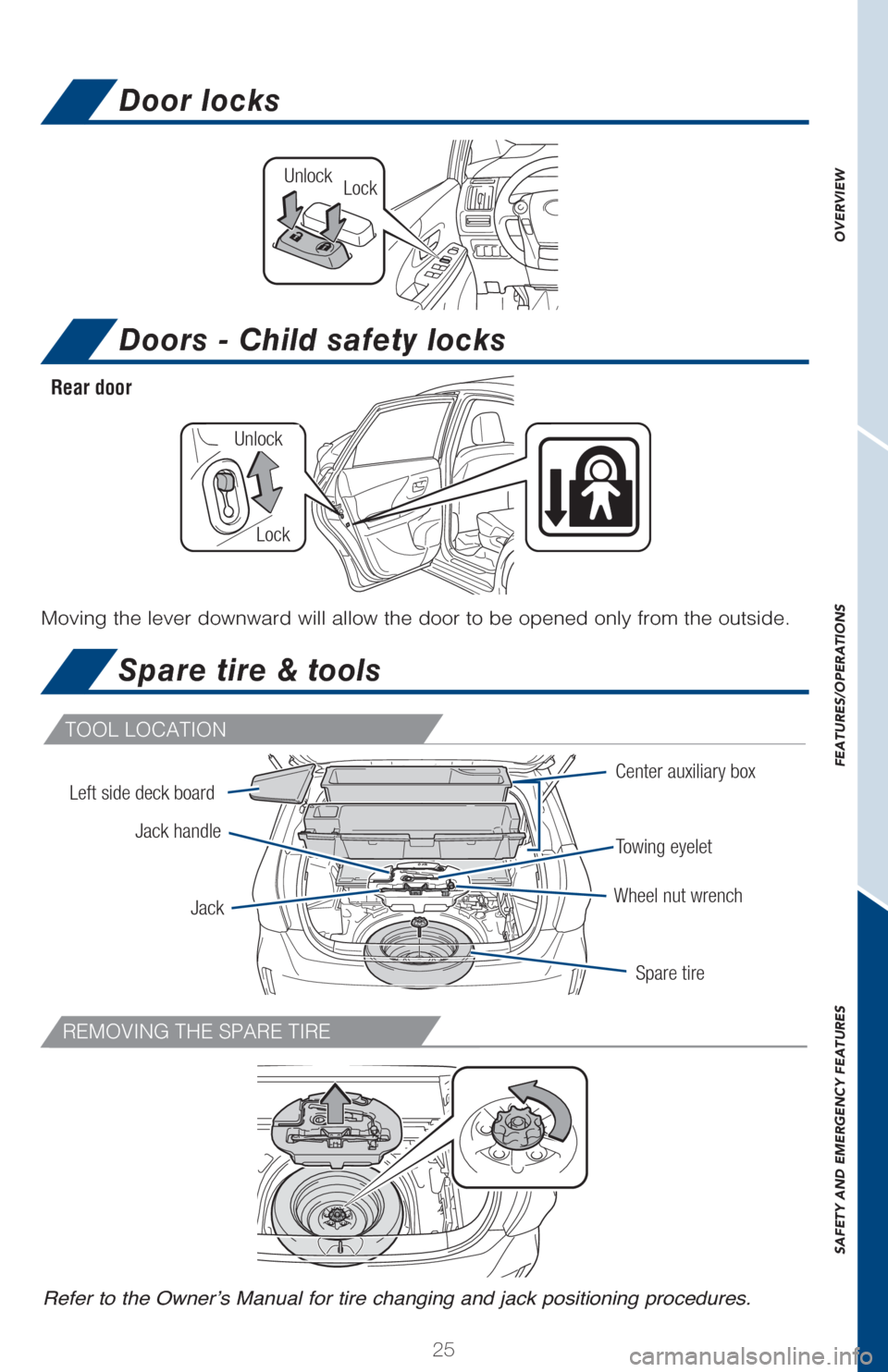
OVERVIEW
FEATURES/OPERATIONS
SAFETY AND EMERGENCY FEATURES
25
TOOL LOCATION
REMOVING THE SPARE TIRE
Door locks
Doors - Child safety locks
Spare tire & tools
Moving the lever downward will allow the door to be opened only from the\
outside.
Rear door
Refer to the Owner’s Manual for tire changing and jack positioning procedures.
Lock
Unlock
Lock
Unlock
Wheel nut wrench
Spare tire
Towing eyelet
Jack
Jack handle
Left side deck boardCenter auxiliary box
Page 28 of 40
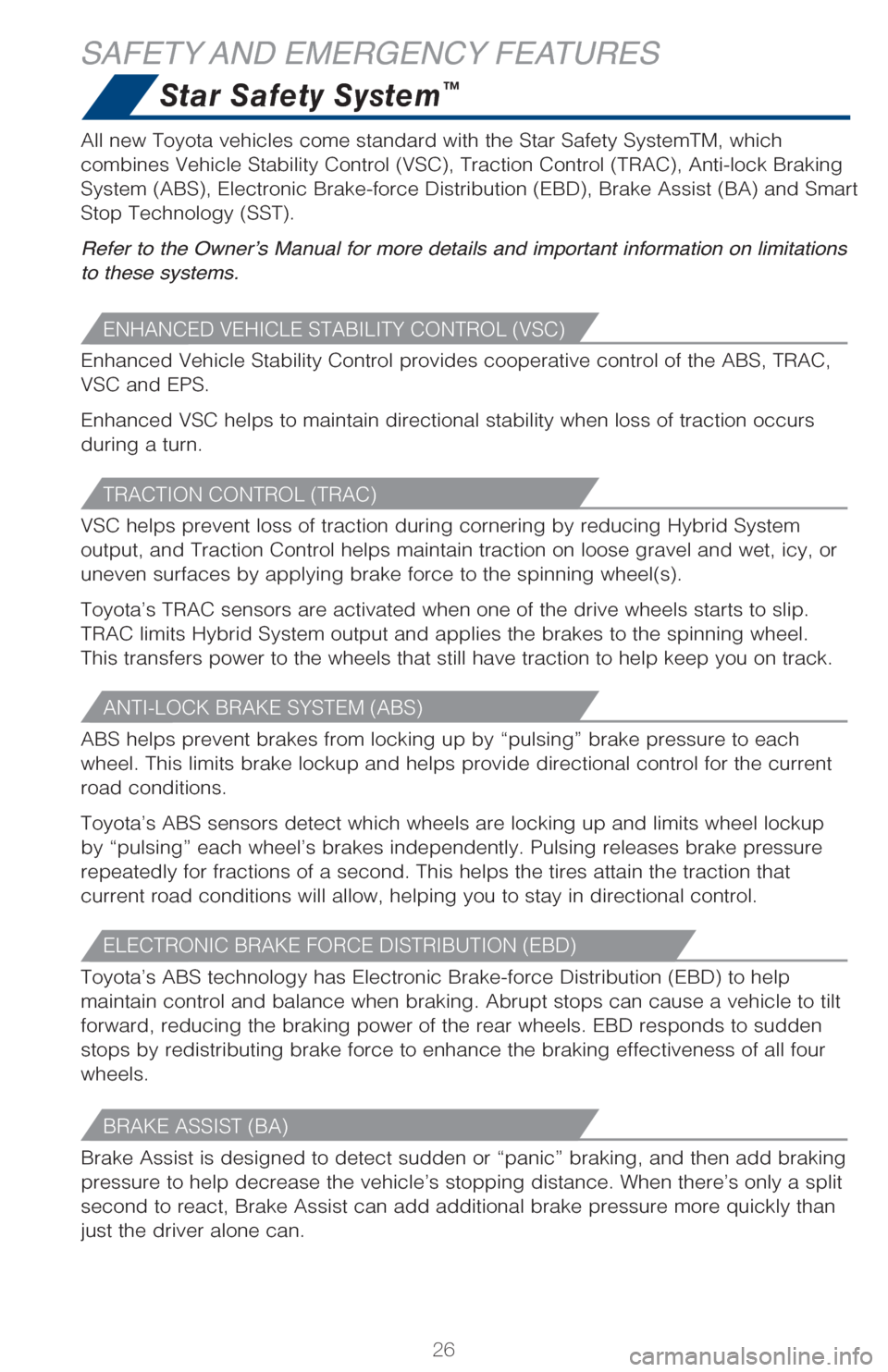
26
SAFETY AND EMERGENCY FEATURESStar Safety System
™
ENHANCED VEHICLE STABILITY CONTROL (VSC)
Enhanced Vehicle Stability Control provides cooperative control of the A\
BS, TRAC,
VSC and EPS.
Enhanced VSC helps to maintain directional stability when loss of tracti\
on occurs
during a turn.
ANTI-LOCK BRAKE SYSTEM (ABS)
ABS helps prevent brakes from locking up by “pulsing” brake pressu\
re to each
wheel. This limits brake lockup and helps provide directional control fo\
r the current
road conditions.
Toyota’s ABS sensors detect which wheels are locking up and limits wh\
eel lockup
by “pulsing” each wheel’s brakes independently. Pulsing release\
s brake pressure
repeatedly for fractions of a second. This helps the tires attain the tr\
action that
current road conditions will allow, helping you to stay in directional c\
ontrol.
BRAKE ASSIST (BA)
Brake Assist is designed to detect sudden or “panic” braking, and \
then add braking
pressure to help decrease the vehicle’s stopping distance. When there\
’s only a split
second to react, Brake Assist can add additional brake pressure more qui\
ckly than
just the driver alone can.
TRACTION CONTROL (TRAC)
VSC helps prevent loss of traction during cornering by reducing Hybrid S\
ystem
output, and Traction Control helps maintain traction on loose gravel and\
wet, icy, or
uneven surfaces by applying brake force to the spinning wheel(s).
Toyota’s TRAC sensors are activated when one of the drive wheels star\
ts to slip.
TRAC limits Hybrid System output and applies the brakes to the spinning \
wheel.
This transfers power to the wheels that still have traction to help keep\
you on track.
ELECTRONIC BRAKE FORCE DISTRIBUTION (EBD)
Toyota’s ABS technology has Electronic Brake-force Distribution (EBD\
) to help
maintain control and balance when braking. Abrupt stops can cause a vehi\
cle to tilt
forward, reducing the braking power of the rear wheels. EBD responds to \
sudden
stops by redistributing brake force to enhance the braking effectiveness\
of all four
wheels. All new Toyota vehicles come standard with the Star Safety SystemTM, whi\
ch
combines Vehicle Stability Control (VSC), Traction Control (TRAC), A\
nti-lock Braking
System (ABS), Electronic Brake-force Distribution (EBD), Brake Assis\
t (BA) and Smart
Stop Technology (SST).
Refer to the Owner’s Manual for more details and important information on limitations
to these systems.
Page 29 of 40
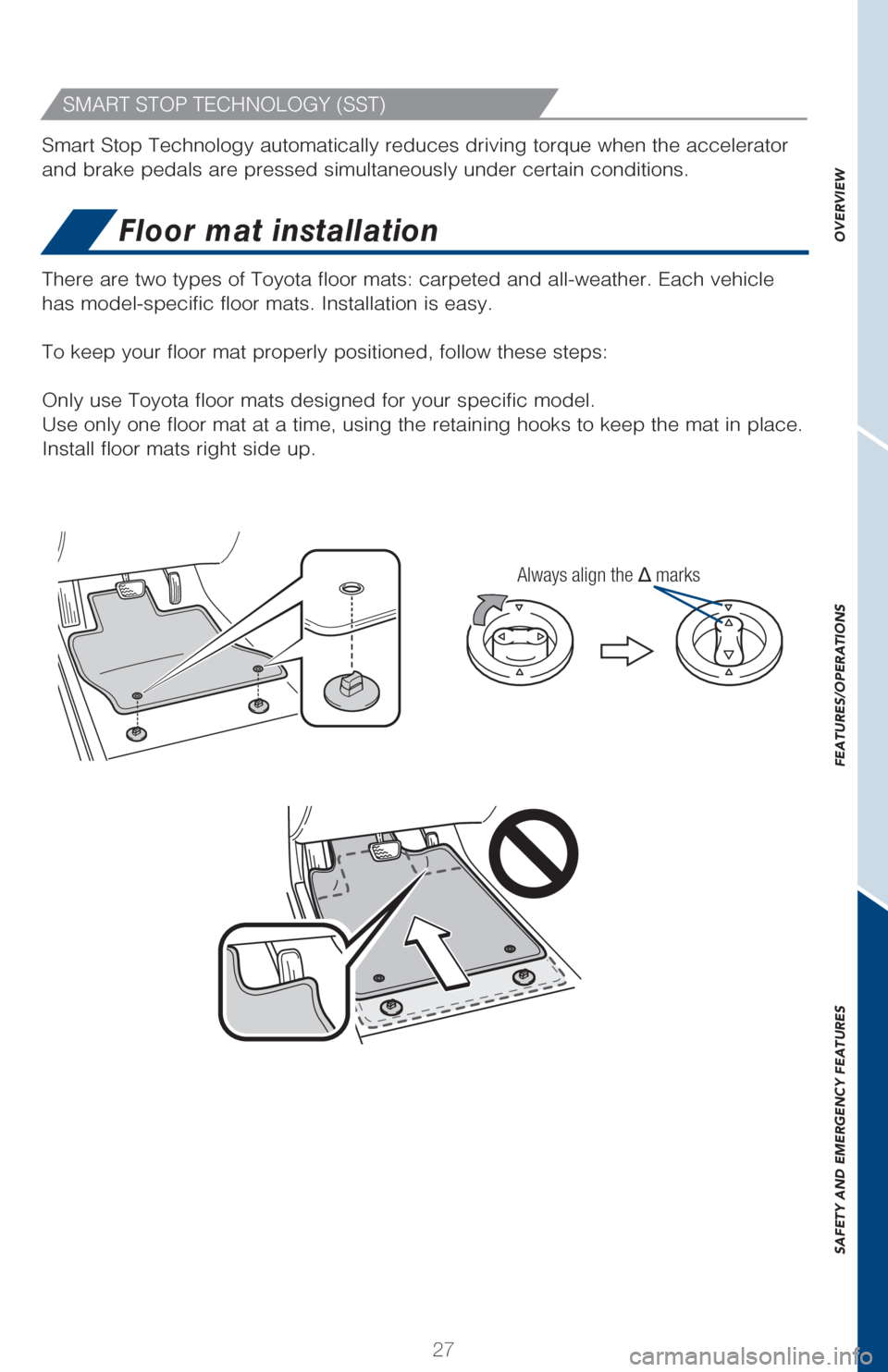
OVERVIEW
FEATURES/OPERATIONS
SAFETY AND EMERGENCY FEATURES
27
Floor mat installation
SMART STOP TECHNOLOGY (SST)
There are two types of Toyota floor mats: carpeted and all-weather. Each\
vehicle
has model-specific floor mats. Installation is easy.
To keep your floor mat properly positioned, follow these steps:
Only use Toyota floor mats designed for your specific model.
Use only one floor mat at a time, using the retaining hooks to keep the \
mat in place.
Install floor mats right side up.
Smart Stop Technology automatically reduces driving torque when the acce\
lerator
and brake pedals are pressed simultaneously under certain conditions.
Always align the Δ marks
Page 30 of 40

28
BLUETOOTH® DEVICE PAIRING
SECTION
Do not attempt the Bluetooth® Pairing process while driving.